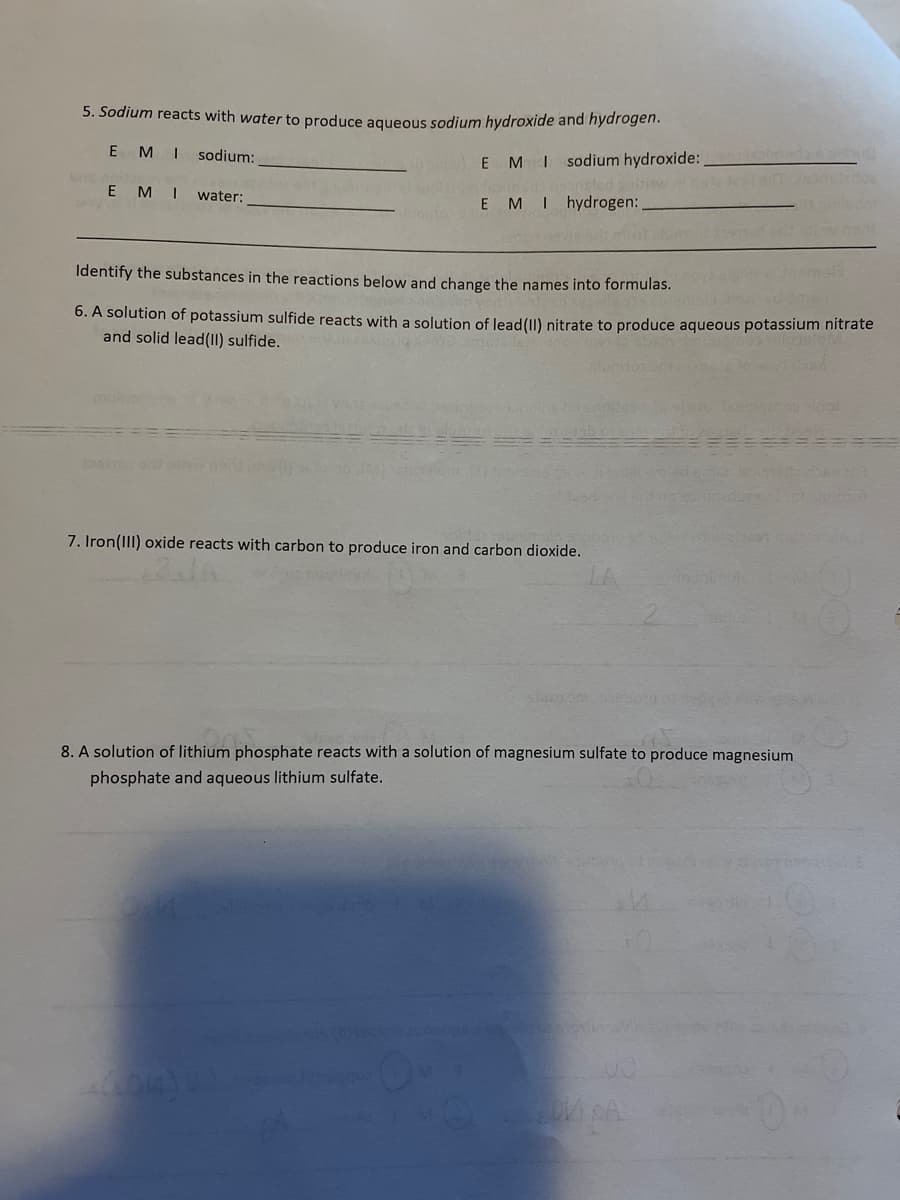5. Sodium reacts with water to produce aqueous sodium hydroxide and hydrogen. E MI sodium: E MI water: E MI sodium hydroxide: angled gain E MI hydrogen: Identify the substances in the reactions below and change the names into formulas. 6. A solution of potassium sulfide reacts with a solution of lead (II) nitrate to produce aqueous potassium nitrat and solid lead(II) sulfide. 7. Iron(III) oxide reacts with carbon to produce iron and carbon dioxide. 3. A solution of lithium phosphate reacts with a solution of magnesium sulfate to produce magnesium phosphate and aqueous lithium sulfate.
5. Sodium reacts with water to produce aqueous sodium hydroxide and hydrogen. E MI sodium: E MI water: E MI sodium hydroxide: angled gain E MI hydrogen: Identify the substances in the reactions below and change the names into formulas. 6. A solution of potassium sulfide reacts with a solution of lead (II) nitrate to produce aqueous potassium nitrat and solid lead(II) sulfide. 7. Iron(III) oxide reacts with carbon to produce iron and carbon dioxide. 3. A solution of lithium phosphate reacts with a solution of magnesium sulfate to produce magnesium phosphate and aqueous lithium sulfate.
Chemistry by OpenStax (2015-05-04)
1st Edition
ISBN:9781938168390
Author:Klaus Theopold, Richard H Langley, Paul Flowers, William R. Robinson, Mark Blaser
Publisher:Klaus Theopold, Richard H Langley, Paul Flowers, William R. Robinson, Mark Blaser
Chapter4: Stoichiometry Of Chemical Reactions
Section: Chapter Questions
Problem 7E: Colorful fireworks often involve the decomposition of barium nitrate and potassium chlorate and the...
Related questions
Question

Transcribed Image Text:5. Sodium reacts with water to produce aqueous sodium hydroxide and hydrogen.
EM I sodium:
insis) E MI sodium hydroxide:
Fanol
E MI hydrogen:
cons
EMI water:
Identify the substances in the reactions below and change the names into formulas.
6. A solution of potassium sulfide reacts with a solution of lead (II) nitrate to produce aqueous potassium nitrate
and solid lead(II) sulfide.
7. Iron(III) oxide reacts with carbon to produce iron and carbon dioxide.
cal And
SOLKO ODE
8. A solution of lithium phosphate reacts with a solution of magnesium sulfate to produce magnesium
phosphate and aqueous lithium sulfate.
Expert Solution
This question has been solved!
Explore an expertly crafted, step-by-step solution for a thorough understanding of key concepts.
Step by step
Solved in 2 steps

Knowledge Booster
Learn more about
Need a deep-dive on the concept behind this application? Look no further. Learn more about this topic, chemistry and related others by exploring similar questions and additional content below.Recommended textbooks for you

Chemistry by OpenStax (2015-05-04)
Chemistry
ISBN:
9781938168390
Author:
Klaus Theopold, Richard H Langley, Paul Flowers, William R. Robinson, Mark Blaser
Publisher:
OpenStax

Introductory Chemistry: An Active Learning Approa…
Chemistry
ISBN:
9781305079250
Author:
Mark S. Cracolice, Ed Peters
Publisher:
Cengage Learning

Chemistry for Engineering Students
Chemistry
ISBN:
9781337398909
Author:
Lawrence S. Brown, Tom Holme
Publisher:
Cengage Learning

Chemistry by OpenStax (2015-05-04)
Chemistry
ISBN:
9781938168390
Author:
Klaus Theopold, Richard H Langley, Paul Flowers, William R. Robinson, Mark Blaser
Publisher:
OpenStax

Introductory Chemistry: An Active Learning Approa…
Chemistry
ISBN:
9781305079250
Author:
Mark S. Cracolice, Ed Peters
Publisher:
Cengage Learning

Chemistry for Engineering Students
Chemistry
ISBN:
9781337398909
Author:
Lawrence S. Brown, Tom Holme
Publisher:
Cengage Learning

Introductory Chemistry: A Foundation
Chemistry
ISBN:
9781337399425
Author:
Steven S. Zumdahl, Donald J. DeCoste
Publisher:
Cengage Learning

Chemistry
Chemistry
ISBN:
9781305957404
Author:
Steven S. Zumdahl, Susan A. Zumdahl, Donald J. DeCoste
Publisher:
Cengage Learning
